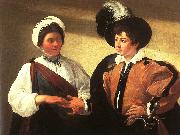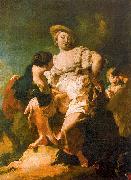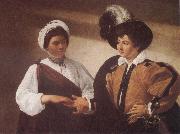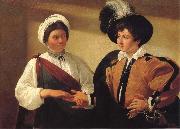
Oil On
Canvas, Real Flavor of Old Masters
|
Caravaggio
|
|||
|
|
|||
| Italian Baroque Era Painter, ca.1571-1610 Italian painter. After an early career as a painter of portraits, still-life and genre scenes he became the most persuasive religious painter of his time. His bold, naturalistic style, which emphasized the common humanity of the apostles and martyrs, flattered the aspirations of the Counter-Reformation Church, while his vivid chiaroscuro enhanced both three-dimensionality and drama, as well as evoking the mystery of the faith. He followed a militantly realist agenda, rejecting both Mannerism and the classicizing naturalism of his main rival, Annibale Carracci. In the first 30 years of the 17th century his naturalistic ambitions and revolutionary artistic procedures attracted a large following from all over Europe. | |||
|
|
|||
|
|
The Fortune Teller Caravaggio11.jpg Painting ID:: 323 Visit European Gallery |
1594-95 Musee du Louvre, Paris | |
Height Width |
INS/CM |
||
|
X |
|
||
|
|
|||
|
PIAZZETTA, Giovanni Battista
|
|||
|
|
|||
| Italian Rococo Era Painter, ca.1683-1754 | |||
|
|
|||
|
|
The Fortune Teller new5/PIAZZETTA, Giovanni Battista-434722.jpg Painting ID:: 19873 Visit European Gallery |
1740 Oil on canvas Gallerie dell'Accademia, Venice. | |
Height Width |
INS/CM |
||
|
X |
|
||
|
|
|||
|
Caravaggio
|
|||
|
|
|||
| Italian Baroque Era Painter, ca.1571-1610 Italian painter. After an early career as a painter of portraits, still-life and genre scenes he became the most persuasive religious painter of his time. His bold, naturalistic style, which emphasized the common humanity of the apostles and martyrs, flattered the aspirations of the Counter-Reformation Church, while his vivid chiaroscuro enhanced both three-dimensionality and drama, as well as evoking the mystery of the faith. He followed a militantly realist agenda, rejecting both Mannerism and the classicizing naturalism of his main rival, Annibale Carracci. In the first 30 years of the 17th century his naturalistic ambitions and revolutionary artistic procedures attracted a large following from all over Europe. | |||
|
|
|||
|
|
The Fortune Teller new9/Caravaggio-645582.jpg Painting ID:: 33570 Visit European Gallery |
mk86 c.1594/95 Oi on canvas 99x131cm Paris,Musee National du Louvre | |
Height Width |
INS/CM |
||
|
X |
|
||
|
|
|||
|
Caravaggio
|
|||
|
|
|||
| Italian Baroque Era Painter, ca.1571-1610 Italian painter. After an early career as a painter of portraits, still-life and genre scenes he became the most persuasive religious painter of his time. His bold, naturalistic style, which emphasized the common humanity of the apostles and martyrs, flattered the aspirations of the Counter-Reformation Church, while his vivid chiaroscuro enhanced both three-dimensionality and drama, as well as evoking the mystery of the faith. He followed a militantly realist agenda, rejecting both Mannerism and the classicizing naturalism of his main rival, Annibale Carracci. In the first 30 years of the 17th century his naturalistic ambitions and revolutionary artistic procedures attracted a large following from all over Europe. | |||
|
|
|||
|
|
The Fortune Teller new10/Caravaggio-322359.jpg Painting ID:: 34695 Visit European Gallery |
mk96 1595 99x131cm | |
Height Width |
INS/CM |
||
|
X |
|
||
|
|
|||










